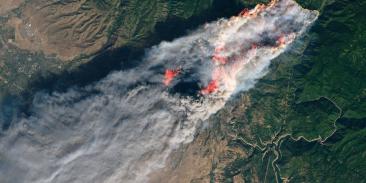Environmental Defense Calls For President Bush To Protect Great Smokies
Environmental Defense today urged President Bush to build upon the solid foundation established by the Clean Air Interstate Rule and support strong U.S. Environmental Protection Agency (EPA) clean air standards to protect Great Smoky Mountains National Park.
On June 15, 2005 — under a court-ordered consent decree with Environmental Defense — EPA is required to issue clean up standards for 26 industrial source categories constructed between 1962-77 that contribute to air pollution problems at Great Smoky Mountains and other protected national parks across the country. The EPA action is due exactly 71 years after the establishment of Great Smoky Mountains National Park on June 15, 1934. In addition to coal-fired power plants, the source categories include industrial boilers, pulp and paper mills, chemical facilities, and cement plants.
“Great Smoky Mountains National Park is a national treasure that must be protected as a sacred American legacy for future generations,” said Environmental Defense senior attorney Vickie Patton. “We call on the president to abandon the flawed Clear Skies legislation, vigorously implement the Clean Air Interstate Rule and, on June 15, support strong EPA clean air standards to protect the Great Smoky Mountains.”
Key facts about Great Smoky Mountains National Park (all from government data):
1. Established by Congress on June 15, 1934, Great Smokies is the most visited national park, with 9.2 million recreational visitors in 2004.
2. Visitors to Great Smokies annually support a total of $821 million in sales, $303 million in personal income (wages and salaries), and 14,588 jobs,
3. Great Smokies is the only national park outside of California to be designated by EPA as part of a “nonattainment” area that is out of compliance with both the federal particulate pollution and ozone health-based air quality standards,
4. During the 2002 high ozone (“smog”) season, the four monitors at Great Smokies recorded a total of 98 exceedances of the health-based ozone standard with 35 at Cove Mountain, 32 at Look Rock, 29 at Clingman’s Dome, and 2 at Cades Cove,
5. The high ozone levels harm ecosystems at the Park with 90 plant species exhibiting injury,
6. Natural visibility conditions are estimated to be 113 miles compared with actual average conditions of 25 miles and worst visibility conditions of 12-16 miles,
7. Acid rain threatens streams, soils and forests at Great Smokies and the acidity of annual precipitation measured at the park is 5-10 times more acidic than natural rainfall,
8. Current air quality conditions at Great Smokies, including actual web camera data, are available from the National Park Service online at: http://www2.nature.nps.gov/air/WebCams/parks/grsmcam/grsmcam.cfm
With more than 3 million members, Environmental Defense Fund creates transformational solutions to the most serious environmental problems. To do so, EDF links science, economics, law, and innovative private-sector partnerships to turn solutions into action. edf.org
Latest press releases
-
Groups File Lawsuit Challenging Trump EPA’s Delay of Protections Against Oil and Gas Methane Pollution
July 31, 2025 -
New study shows how sectoral emissions shape today’s warming and tomorrow’s risks
July 30, 2025 -
EPA Administrator Zeldin Delays Commonsense Methane Pollution Protections
July 29, 2025 -
NEW: U.S. Government’s Own Analysis Shows Repealing Tailpipe Pollution Standards Will Sharply Increase Gasoline Prices
July 29, 2025 -
Trump Administration Tries to Eliminate Endangerment Finding, Clean Car and Clean Truck Standards
July 29, 2025 -
Illinois Approves Electric Rate Encouraging Use of Clean Affordable Energy
July 28, 2025










